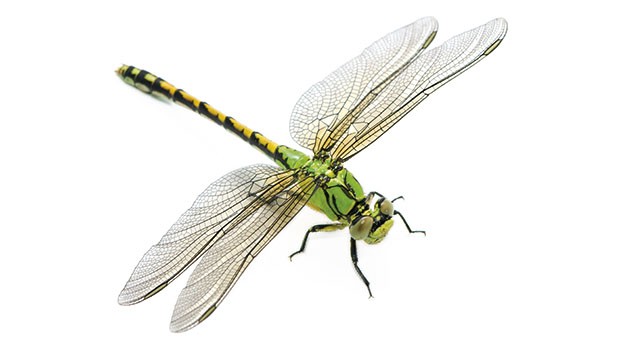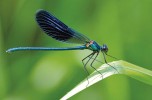In Italia è record di presenze: 93 le specie segnalate. Ma il 19% delle libellule europee sono a rischio
È senso di stupore quello che ormai si sente avvistando una libellula svolazzare attorno a fiumiciattoli e rivoli d’acqua. «Guarda! Una libellula!», capita di dire indicando quell’insetto cangiante dal volo silenzioso ed estremamente elegante in cui è sempre più difficile imbattersi.
Il nome “libellula” deriva dal latino “libra”, che significa “bilancia”, in quanto questo insetto mantiene le ali orizzontali durante il volo. Viste di vicino, le libellule sono insetti davvero affascinanti: hanno un capo molto voluminoso, da cui spuntano due piccole antenne, occhi grandi simili a quelli della mosca e composti da ben 50 mila ommatidi, e due paia di ali quasi uguali, allungate e membranose, a volte di colori vivaci.
I disegni fitti fitti che si possono osservare sulle ali della libellula, simili alle venature di una foglia, sono delle vere opere di astrattismo. Le zampe sono nella parte anteriore del corpo, ma raramente sono usate per camminare; per lo più le libellule volano per spostarsi, raggiungendo anche i 50 chilometri orari.
L’addome è lungo e sottile, composto da undici segmenti. Il labbro inferiore è fornito di piccole pinze con cui la libellula riesce ad afferrare la preda. Questo e il volo silenzioso veloce fanno di lei un temibile predatore per gli altri insetti, sia in cielo che in acqua. La libellula appartiene all’ordine degli Odonati, il che significa che la sua sopravvivenza dipende fortemente e dalla buona qualità delle aree umide. Infatti questo insetto passa le fasi più importanti del suo ciclo vitale nelle acque lotiche e lentiche: la riproduzione e lo sviluppo larvale.
Dopo aver deposto le uova, che hanno una forma allungata, la libellula le lascia semplicemente cadere nell’acqua. Come per tutti gli odonati, la loro è una metamorfosi incompleta: dalle uova escono delle neanidi che maturano nell’acqua, cibandosi di varie piccole forme di vita acquatiche. Il periodo ninfale può durare fino a tre anni, a seconda della specie, durante i quali l’insetto va incontro alla muta almeno dieci volte. Una volta mature, le ninfe abbandonano l’acqua e attraversano la metamorfosi definitiva, divenendo libellule adulte.
Mediterraneo, terra di libellule (in pericolo)
Il fatto che la loro presenza dipenda dalla qualità dell’habitat fa sì che spesso vengano usate come indicatori dello stato di salute dell’ambiente, nella gestione della sua conservazione e nell’analisi dei cambiamenti a breve e lungo termine. La regione del Mediterraneo vanta il più alto livello di endemismo, quindi la maggiore varietà di libellule, ma - ahinoi - anche la più alta percentuale di specie a rischio di estinzione. Delle 166 specie che popolano il bacino mediterraneo, ben il 19% (ovvero 31 specie) sono nella lista rossa dello IUCN (International Union Conservation of Nature), senza contare le quattro già estinte nella regione.
La causa principale di questo danno enorme alla nostra biodiversità è la perdita e la degradazione degli habitat, quindi l’intensificazione dell’attività agricola e l’inquinamento delle acque dolci. L’Italia, comunque, all’interno del bacino del Mediterraneo, è il paese con il maggior numero di specie di libellule con ben 93 specie segnalate.
Nove di queste sono di interesse comunitario, per cui la loro conservazione richiede la designazione di zone speciale. La maggior parte però non corre ancora nessun rischio di estinzione imminente: il 72% delle libellule italiane sembra per ora al sicuro. Ma per far sì che la situazione non degeneri, è bene che questo record positivo non ci faccia ignorare l’importanza di politiche di conservazione e difesa efficaci.
Laura Spataro
Skimmers, small, graceful water predators. In Italy, numbers are at record levels. There are 93 recorded species. But 19% of European skimmers are at risk
It is with a sense of amazement that we now hear a skimmer flying around a stream and watercourse. “Look! A skimmer!”, we hear being said about that iridescent insect with its silent and extremely elegant flight which we come across more and more rarely.
Its scientific name, libellula, derives from the Latin ‘libra’ which means balance as this insect keeps its wings horizontal as it flies. Seen from close to, these are truly attractive insects: they have very large heads from which stick two small antennae, large eyes like those of flies and made up of a grand total of 50 thousand ommatidia and two almost identical pairs of elongated, membranous wings, sometimes in bright colours.
The very dense patterns which can be seen on the skimmers’ wings, like veins of a leaf, are truly works of abstract art. Their legs are in the front of their bodies but are rarely used for walking. For the most part skimmers fly to move around, reaching speeds of up to 50 kilometres per hour. Their abdomens are long and thin and made up of eleven segments.
Their lower lips are equipped with small pincers with which they grasp their prey. This and their silent flight makes them a frightening predator for other insects both in the skies and in the water.
Skimmers belong to the Odonata order which means that their survival depends mainly on the availability of good quality wet habitats. It is in lotic and lentic waters which this insect passes the most important phases of its life cycle: reproduction and larvae development. After laying its eggs, which are elongated in form, skimmers simply let them fall into the water. Like all Odonata, theirs is an incomplete metamorphosis: the eggs hatch to produce neanids which develop in the water, feeding off various forms of small aquatic life.
The nymphal period can last up to three years, depending on species, during which time they shed their skin at least ten times. Once mature the nymphs leave the water and undergo their definitive metamorphosis, becoming adult skimmers.
The Mediterranean, land of skimmers (at risk)
The fact that their presence depends on the quality of their habitat means that they are frequently used as indicators of the state of an area’s environmental health, in the management of their conservation and short and long term change analysis. The Mediterranean region boasts the highest level of endemisms and thus the largest variety in skimmers but, alas, also the highest percentage of species at risk of extinction.
Of the 166 species which populate the Mediterranean, a grand total of 19% (i.e. 31 species) are on the IUCN’s (International Union Conservation of Nature) red list without taking account of the four species already extinct in the region. The main cause of this huge damage to our biodiversity is the loss and degradation of their habitats and thus the intensification of agriculture and polluted fresh water.
Within the Mediterranean, however, Italy is the country with the largest number of skimmers with a grand total of 93 species reported. Nine of these are of EC interest and their conservation requires the designation of special zones. The majority of these run no imminent risk of extinction, however, and 72% of Italian skimmers are currently safe. To ensure that the situation does not degenerate further, however, it is important that this positive record does not lead to conservation policies and effective safeguards being ignored.
















